市场资讯及洞察
.jpg)
摘要
IEA 最新月报显示,全球石油需求增速放缓但仍具韧性。尽管库存持续回升,但 OECD 库存整体仍低于五年均值,市场对供应中断高度敏感。OPEC、IEA、EIA 均上调非 OPEC 供应,未来可能出现“松中带紧”的供需结构。原油价格在供应宽松预期与地缘扰动之间反复震荡,波动率下降但敏感度上升。油市表现也可能通过风险偏好外溢至能源板块、商品货币及相关市场。
一、全球原油供需前景:IEA 月报核心要点
国际能源署(IEA)最新原油月报显示,全球石油需求虽较去年降温,但整体依旧保持韧性 [1]。先进经济体消费表现好于预期,有效抵消部分新兴市场的疲弱需求。IEA 预计 2025–2026 年全球石油需求将保持温和增长。然而在供应方面,如果 OPEC+ 维持当前产量政策且需求不出现明显下滑,全球石油市场未来数个季度可能重新进入“边际紧平衡”状态。IEA 同时指出,高油价、全球经济放缓、电动车渗透等因素正在逐步压制需求增速,使油市呈现出“短期紧平衡、长期温和宽松”的结构。
二、多机构观点对比:OPEC、EIA 与 OECD 数据
三大机构对于未来市场平衡的看法存在显著差异,这主要源于对非 OPEC+ 供应增长和需求韧性的不同假设。总体来看,市场普遍认同未来供应将更加充裕,但对于过剩的规模和时间点存在分歧。

图 3:三大机构对 2025-2026 年需求与供应增长的预测对比,显示供应增长普遍超过需求增长,预示市场将进入供应过剩周期。
OPEC 的观点相对乐观。OPEC 预计 2025 年全球石油需求将增长约 130 万桶/日,2026 年略高至 140 万桶/日 [2]。与此同时,OPEC 在最新报告中连续上调非 OPEC 供给预期,并首次将 2026 年市场从“短缺”调整为“小幅过剩”,反映其判断未来供应增长可能快于需求。
EIA 的判断更偏向供应充裕。EIA 上调了美国页岩油产量预测,指出 2025 年美国原油产量将创历史新高。同时,全球供应预期被上调至日均 1.06 亿桶,高于全球消费的 1.041 亿桶,意味着未来库存可能持续累积 [3]。EIA 预期 2025–2026 年库存增加将对油价形成中期压力。
OECD 库存虽然持续回升,但仍低于五年均值。IEA 数据显示,今年全球观测库存前八个月净增约 2 亿桶,但 OECD 商业库存仍比五年均值低约 6700 万桶。整体来看,库存虽然恢复,但仍处历史偏低区间,使油市对供应中断的敏感度依旧很高。
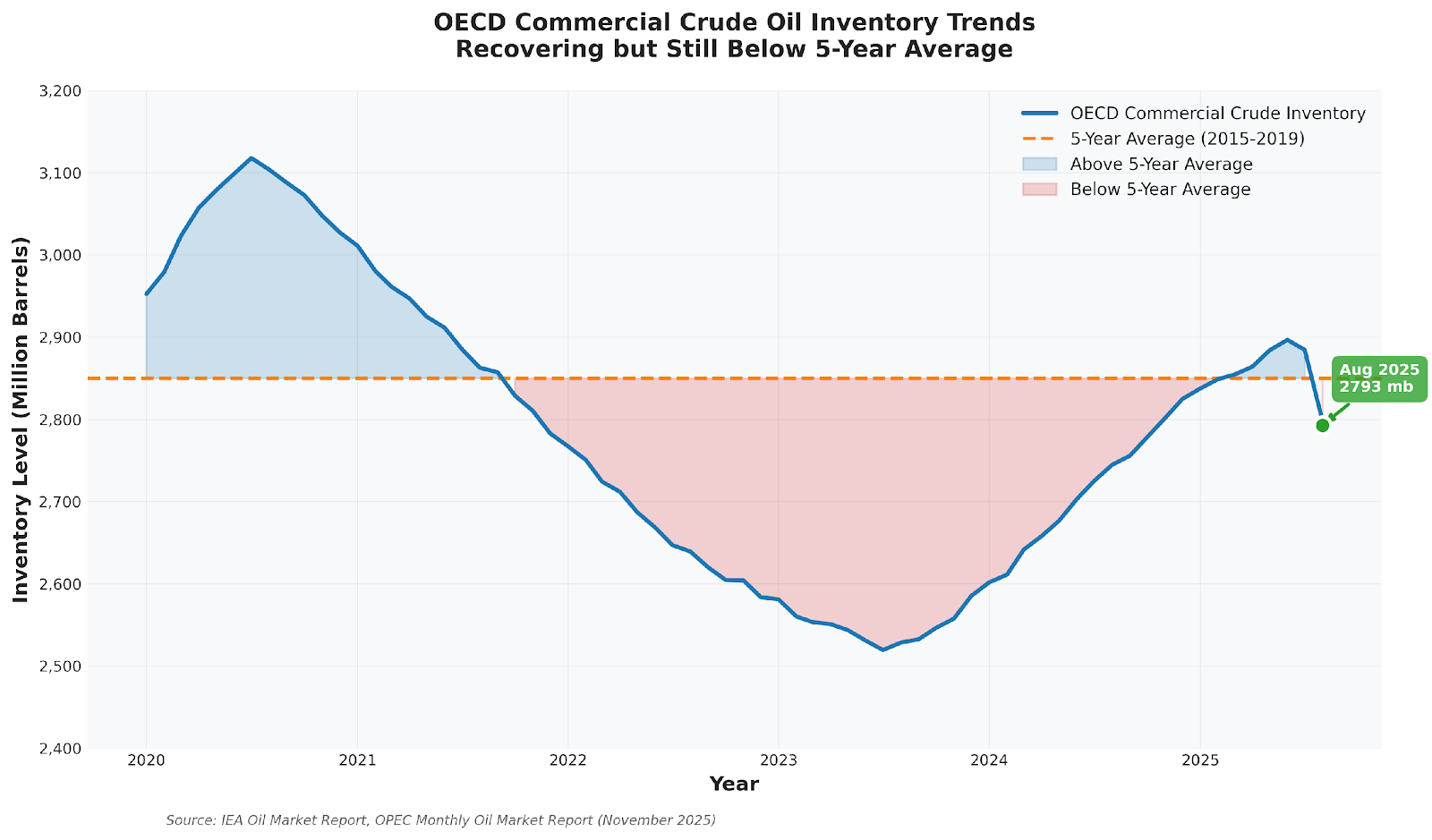
图 1:OECD 商业原油库存近 5 年对比最新水平,显示库存虽有回升但仍低于五年均值。
三、原油价格走势:WTI 与 Brent 如何消化预期
2023 年下半年,布伦特因供应紧张和地缘冲突预期一度突破每桶 90 美元。然而进入 2024–2025 年,随着供应回升和库存恢复,油价整体震荡下移。近期价格承压主要来自供应过剩预期强化以及美国库存意外上升。
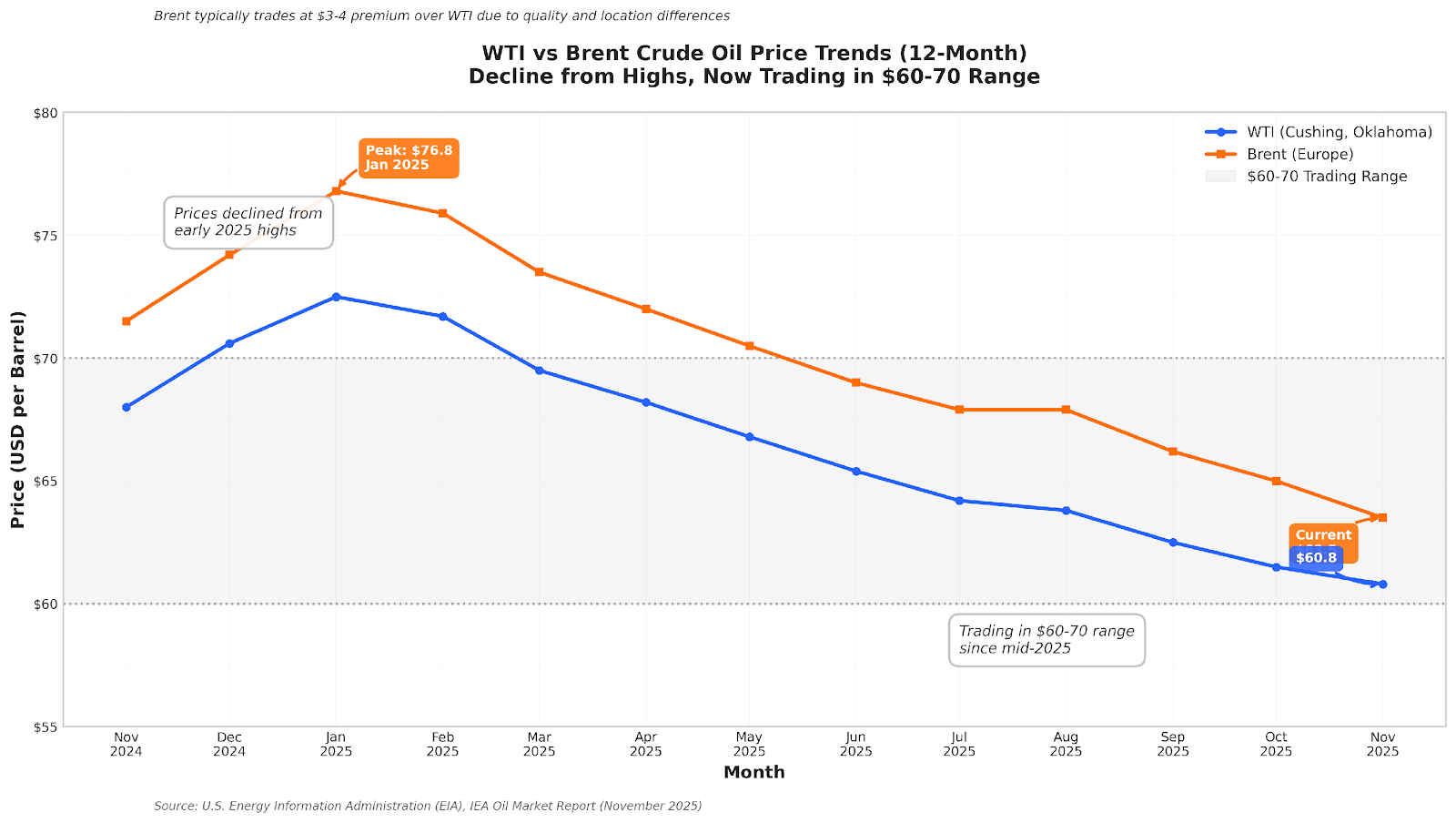
图 2:WTI 与 Brent 价格从 2025 年初的高位回落,近期在 60–70 美元区间震荡。
尽管地缘事件偶尔推升价格,但反弹难以持续,因为供应宽松的结构性预期迅速重新主导市场。WTI 与 Brent 的期限结构一度出现小幅 Contango,显示短期供应充裕压制近端价格,而远月因长期需求预期而保持相对坚挺。整体来看,油市呈现低波动、弱趋势但对消息高度敏感的特征。
四、驱动油市的关键变量:地缘政治与供应端不确定性
运输通道风险仍是油市最大的潜在冲击点之一。全球三分之一海运原油经过霍尔木兹海峡,一旦受阻便可能引发油价剧烈波动。衍生品定价显示断供概率虽低,但属于典型的“低概率、高冲击”事件。
OPEC+ 的政策滞后性也带来结构性波动。减产会压低库存、推高价格,但高油价又刺激非 OPEC 增产,使市场重新宽松。美国页岩油增速放缓进一步加剧供应端的不确定性,削弱其作为“摇摆产能”的角色。此外,俄罗斯、伊朗等国因制裁和冲突导致出口波动,更加剧油市敏感性。
五、油市变化的外溢影响
能源板块通常与油价同方向变动,但反应速度较油价更平缓。油价对风险偏好的溢出效应也容易影响澳元等商品货币。大宗商品价格上行往往提升商品出口国的贸易条件与风险情绪,而价格下跌则可能压制相关货币表现。
六、原油市场风险提示
- 数据发布风险: EIA 每周库存、IEA 与 OPEC 月报可能导致短线波动。
- 地缘政治风险: 产油区冲突、海运通道中断、制裁变化均可能影响供需平衡。
- 宏观风险: 利率政策、美元走势及全球经济增速变化都可能改变需求前景。
结语
IEA 最新展望显示,全球油市进入“边际紧平衡”阶段:库存修复但仍偏低,供应端不确定性大于需求端。在这种结构性环境下,油市会对政策、地缘事件与供给变化表现出高度敏感。理解供需框架、关注库存趋势与识别关键风险,将是未来判断油市走向的关键。
参考资料
[1] IEA (International Energy Agency). (2025, October). Oil Market Report - October 2025. https://www.iea.org/reports/oil-market-report-october-2025
[2] OPEC (Organization of the Petroleum Exporting Countries). (2025, November). Monthly Oil Market Report. https://publications.opec.org/momr
[3] EIA (U.S. Energy Information Administration). (2025, November). Short-Term Energy Outlook. https://www.eia.gov/outlooks/steo/


热门话题
公司简介Paladin Energy Ltd (PDN-AU) 帕拉丁能源公司,从事铀矿的开发和运营。其主要的业务是铀氧化物 U3O8 的销售和贸易。它通过以下部门运营:勘探部门、纳米比亚部门、马拉维部门和澳大利亚部门。勘探部门:其部门主要专注于开发、勘探和评估项目,其中包括地区为澳大利亚和加拿大。在 Michelin 项目上 Paladin 通过其全资子公司 Aurora Energy Ltd (Aurora) 持有52,250 公顷矿产许可的 65% 权益。这个项目主要位于加拿大拉布拉多的中央矿带内。Michelin 项目是在这个矿带的最大矿床。作为该项目的旗舰矿床,米其林总矿产资源量为 12770 万磅铀,其中 90%被列为已测量和指示矿产资源。纳米比亚部门: 纳米比亚部门的的主要业务是对在纳米布亚的铀矿进行生产和销售。纳米比亚部门的运营是借助于帕拉丁能源旗下的 Langer Heinrich Uranium Ltd 去管理和开采 Langer Heinrich 矿。Langer Heinrich 矿是全球核燃料能源循环中经过验证的一级资产。铀市场状况的下滑导致帕拉丁于 2018 年 5 月将 Langer Heinrich 置于护理和维护之中。现在,帕拉丁能源已完成的研究和计划。确认了重启资金(81million)、成本(US$27/lb)和运营绩效(产出 7 年内 590 万磅 U3O8 pa ),以及未来提高运营可靠性和实力的机会。

马拉维部门: 马拉维部门涉及位于马拉维矿区的生产和销售。(马拉维曾被联合国评为世界上最不发达的国家之一,其主要的产业是农业,是非洲主要烟草出口国,烟草出口占国家外汇收入 70%)。澳大利亚部门: 纳米比亚和马拉维部门涉及从位于这些地理区域的矿山生产和销售铀。澳大利亚分部包括其销售和营销、资金、公司和行政管理,还包括为完成销售订单而购买的股票收入。澳大利亚部门持有 Mount Isa 和 Manyingee 项目的权益。其中Mount Isa 的总矿产资源是 14830 万磅,是昆士兰最大的铀矿。

行业分析:目前澳大利亚的铀储存量 167.3 万吨占世界的 31%,但是产量量仅仅占全世界的10%不到。在澳大利亚,铀矿的勘探和开采有着严格的法律约束,这样的情况下,澳洲是不太愿意建立新的油田,不仅不放宽开采限制,甚至还越来越严格。在对于资源的重点保护下,澳洲还有很大份额的铀未见天日。在近五年来,铀的价格波动性较大,造成了收入的不稳定性。
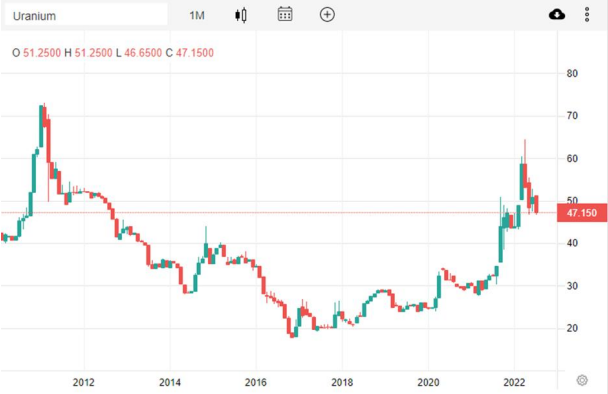
在 2011 年福岛核电站核泄漏之后,核能源环境污染和较高危险性成为世界关注的话题,核电站的安全性再次被质疑。后果就是铀作为核动力能源的关键材料,需求骤降,价格出现暴跌,以至于之后五年铀的价格一直都一蹶不振。在近五年,渐渐地有一些好转。更详细的美联储加息历史复盘,请联系小助手获取。免责声明:GO Markets分析师或外部发言人提供的信息基于其独立分析或个人经验。所表达的观点或交易风格仅代表其个人;并不代表GO Markets的观点或立场。联系方式:墨尔本 03 8658 0603悉尼 02 9188 0418中国地区(中文) 400 120 8537中国地区(英文) +248 4 671 903作者:Neo Yuan | GO Markets 助理分析师


热门话题
加息周期中,美股的表现可以分为两种情况:第一,美股面临盈利上行+货币紧缩的组合。此时美股通常会在加息初期出现 一定幅度的调整,持续时长也通常在 几个月以内。随后盈利上行仍将支撑美股继续走高。直到盈利增速出现下行,或投资者对盈利的预期转弱,美股才会真正开启大级别的下跌行情,而这通常发生在加息周期结束之后。

第二,美股面临盈利下行+货币紧缩的组合。美国经济处于滞胀状态,典型如 20 世纪 70 年代。这段时期,美股通常在货币政策收紧之前就出现调整,因为经济下行压力已经开始显现。当估值达到低位,或滞胀结束时美股就走稳见底。从 1965 年以来,美联储加息一般不会成为美股进入技术性熊市的触发因素。联储加息是为了应对经济增长过热的风险。所以在货币政策刚刚开始收紧时,美股面临着盈利上行和流动性收紧这两股相反的力量,更偏向于震荡。直到投资者对盈利走弱的担忧增强时,美股才会出现调整。典型如 2018 年 9 月、2015 年 8 月、2000 年 3 月、1973 年 1 月等均是如此。较为特殊的情况是,美联储加息期间,美股同时面临其他利空,此时美股的表现不佳。如 1972 年 4月-1974 年 7 月,美国经济处于滞胀阶段,美联储加息以应对通胀问题。再如 1977 年 4 月-1981 年 7 月,美元危机爆发、美元指数下跌、美国国际收支恶化等迫使美联储加息,但同时经济已处于下行期。整体上看,美股在加息期间大跌的概率不高,基本面下行才是核心利空。

目前的实际情况是,美联储加息进入中期阶段,经济停滞增长和高通胀基本表明美国陷入滞涨,美股也从年初已经经历了大幅度的回撤。目前其实企业的盈利都是偏好的,接下去美股进入反弹行情的概率远远大过继续下跌。复盘加息周期 1:伴随着通胀压力的走高,美联储在 1999 年 6 月至 2000 年 5 月持续 6 次加息,累计幅度为 175bp,利率从 4.75%提高到 6.5%。在此之前,美国经济已连续上涨近 10年。在逐步摆脱了储贷危机之后,1992Q1 之后的每个季度美国实际 GDP 增速均保持在 2%以上。加息期间美国经济增速小幅放缓,但 GDP 增速的环比折年率仍维持在 4%以上。在加息初期,美股出现小幅波动。标普 500 指数从 1999 年 7 月 16 日的 1419 点下跌至 1999 年 10 月 15日的 1247 点,跌幅达到 12%,持续时间长达 13 周。从估值与盈利的贡献程度来看,这段时期标普 500 的市盈率从 1999 年 6 月的 29.88 下降至 9 月的 27.03,估值跌幅达到 9.5%,本轮调整大多由估值贡献。在加息中期,盈利支撑美股继续上行。从 1999 年 10 月到 2000 年 4 月,美股迎来了一波反弹,标普 500 指数从 1999 年 10 月 15 日的 1247 点上涨到 2000 年 4 月 7 日的1516 点,涨幅超过 20%。随着初期加息市场担忧情绪的消退,美股迎来了估值和盈利的双双上行。其中估值在 2000 年 3 月回升至 28.94,接近加息前的水平,同期标普 500 指数净资产收益率(ROE) 连续走高,GDP 增速也维持在一个比较稳定的水平。值得关注的是,即使是2000 年 2 月下旬美国国债利差(10y-2y)倒挂也没能阻止美股的上涨行情。在加息末期,市场对美股盈利下行的担忧加剧,互联网泡沫破裂就此开启。标普 500 指数在 4 月 7 号冲至高点后开始回落,随后开始了一波两年之久的下跌行情。美股在 4 月开启调整的触发因素有,微软公司反垄断案引发市场对互联网企业盈利前景的担忧(2000 年 4 月)、国际油价走高加重了市场对美联储加息的担忧。

事后来看,美股盈利的下行才是驱动行情的关键因素,标普 500 指数ROE 在达到 2000 年 5 月的 18%后开始迅速走弱,直到 2002Q2 止跌,由期初的 16.32%下降至9.92%,降幅达到了 6.4%。这个降幅创出了历史新高。美股盈利下行既有宏观经济走弱、911事件冲击的影响,也有上市公司财务造假丑闻暴露、此前虚增的利润回吐的影响。更详细的美联储加息历史复盘,请联系小助手获取。免责声明:GO Markets分析师或外部发言人提供的信息基于其独立分析或个人经验。所表达的观点或交易风格仅代表其个人;并不代表GO Markets的观点或立场。联系方式:墨尔本 03 8658 0603悉尼 02 9188 0418中国地区(中文) 400 120 8537中国地区(英文) +248 4 671 903作者:Xavier Zhang | GO Markets 专业分析师


Maturity, Yields, Par Values and Coupon payments. These are words that everyone has heard of but not many have a good understanding of what they mean. In this article all these complicated terms will be explained.
Please note that while this information is most relevant for physical bonds, it is still important to understand when dealing with CFD’s as they play an important role in how bond CFD’s are valued. What is a Bond? A bond is an instrument that is used by companies and governments and other entities to raise money through the issuing of debt.
There are different typed of bonds however, the simplest bonds are contracts in which an issuer (Company/Government) receives a payment from the purchaser or bond holder in exchange for the rights to interest plus the principal amount. For example, a government may issue a 10-year bond for $1000 in which they agree to pay 1% interest per annum which will equate to $10 per year. In addition, they will pay back the principal amount once the bond matures.
Key Terms Issuer – The entity that sells the bond initially and must make payments. Holder – The entity who is possession of the bond. Principal – The amount of debt that the government/company has taken that will be paid at maturity.
Par Value – The nominal value of the bond or the price when it was issued. Coupon Payment - The interest payment that is paid to the bond holder. Yield –The coupon payment divided by the Bonds face value.
Maturity – The date when the principal amount of the bond will be paid back. Bond Ratings Generally, Bonds are rated according by agencies, based on how safe the underlying assets are. For instance, government bonds tend to be rated the highest as they are guaranteed by the government, and governments are highly unlikely to default.
In a practical sense, the US government is such a reliable issuer that it should never default on the repayments. This makes Bond’s a great asset to act as a hedge against unsystematic risk. On the other hand, corporate bonds may be given lower ratings depending on their credit risks.
Inverse Relationship between Bond Price and Yield The price and yields for bonds are inversely related. This is important to note as bonds are often charted against their yield and not price which is how derivatives are often charted. Therefore, a trader should be aware of the inverse relationship between price and yield.
This occurs because as the price of a bond changes up or down the interest rate must adjust to ensure that the coupon payment is the same. Assume Bond A is issued at $1000 dollars and 10% interest rate to pay a $100 coupon. 1 Year later that same bond is now priced at $900, however the bond must still pay out a $100 coupon. However, to get a coupon payment of $100, the interest rate must increase.
The formula below shows this: $900 x Interest Rate = 100. Simple Algebra shows that the interest rate = 11.1% Understanding this relationship will make eliminate one of the more confusing elements of trading bonds. Catalysts for Bond Prices The general factors that influence a bond’s price are related to the interest rates and the broader economy.
For instance, if the market interest rate 2% and the bond’s coupon rate is 1%, then the bond will trade at a lower price and vice versa. Subsequently, bonds can be a handy way of tracking the sentiment as they often reflect the feeling in the market. Economic events can impact on the performance of bonds.
When the economy is growing and equities are doing well, bonds tend to perform worse as the return is limited. However, during times of volatility and poor stock market performance, the bond market tends to perform better as the market looks for safety in the guaranteed returns from bonds. Inflationary pressure and low or high interest rates can influence the direction of the way in which bonds are traded.
Generally, in a strong economic market, bonds with longer maturities tend to have higher yields than those in shorter maturity. This is generally due to the thought that the time that is further in the future will has more uncertainty than that in the near-term future. The general exception to this is when the market expects a recession soon.
This causes what is known as an inverted yield curve, in which the shorter-term bond is yielding a higher interest then the long-term bonds. You can trade CFD on the 10 Year US treasury note, 5 Year US treasury Note, UK Gilt, Euro Bund and the JGB Japan Futures on Go Markets Metatrader 5 platform
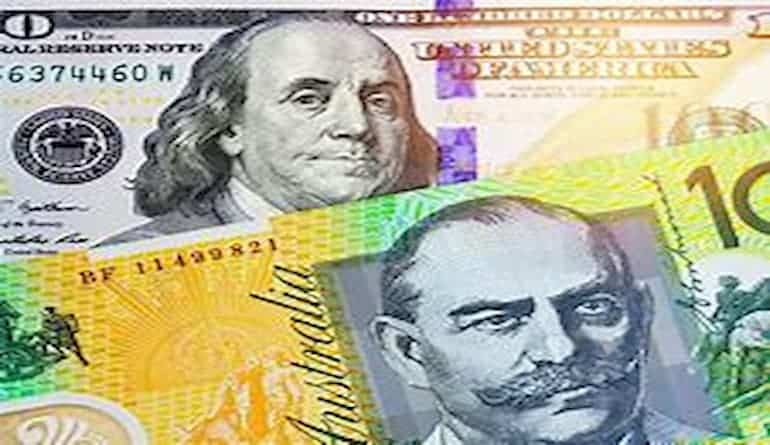

The AUD has fallen to lows not since the beginning of the Covid 19 pandemic and does not look like stopping anytime soon. With global commodity prices coming down and fears of a recession causing panic sell offs the AUD has been victim to a two-fold attack. The general recession fears push growth assets including the Australian dollar downward as investors look to put their money into safer assets.
In addition, as the USD has increased commodity prices have come down. Going forward, with presumably with recessionary fears only set to get worse globally and inflation in Europe and the UK potentially reaching 20% central banks have had no choice but to be aggressive with their monetary policy. The slowing growth has been a cause for concern as growth assets alongside the AUD have sold off.
Therefore, until there is really a peak in inflation or signs from the Federal Reserve that it intends to back off its hawkish stance, the AUD may very well continue to dive. Technical Analysis On the weekly chart the price currently in a nosedive with no obvious support in sight. The closest support in still $0.04 away at $0.60 which were the GFC lows.
If that level goes, then the next target is $0.55 which was the price during the initial stages of the Pandemic. Just as concerning is the fact that the 50-week moving average is almost ready to cross below the 200 week moving average. This is a lagging indicator that shows that the pair is very much being controlled by the sellers.
In addition, the RSI also still has room to drop further down to reach the level of the Covid 19 levels. The daily price chart confirms the analysis above and if anything shows a more systematic down trend. With both 50 day and 200 day moving averages trending down it does not bode well for a reversal any time soon.IN addition, the price has not been able to breakthrough both averages at for a significant period since June 2021.
Whilst the market can turn quickly, there is still s much fear and panic around that it is hard to see the AUD turning in the short term.
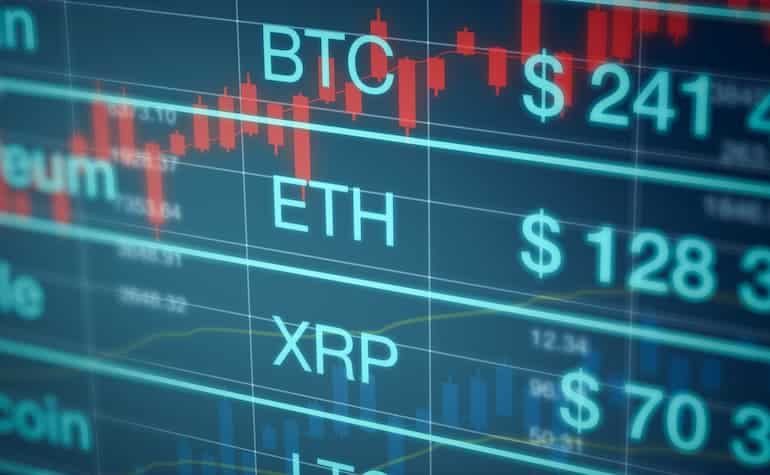

Following the previous Bitcoin analysis ( https://www.gomarkets.com/au/articles/economic-updates/bitcoin-usd-technical-analysis/ ), bitcoin continues to break below pattern after pattern, recently breaking out and re-testing a descending flag pattern on a 4h time frame as seen below: With the next major support sitting around $17,619, it won’t be a surprise if bitcoin comes down to that area. Looking at the correlation between Bitcoin and Ethereum, the last 7 days of price action shows a correlation of.89, which is a positive value that indicates a positive correlation between the two. A positive correlation means that the two moves very similar to one another. [caption id="attachment_273298" align="alignnone" width="602"] (https://cryptowat.ch/correlations)[/caption] [caption id="attachment_273299" align="alignnone" width="527"] (https://cryptowat.ch/correlations)[/caption] For ETHUSD (Ethereum), making similar patterns to BTCUSD, has also recently broken out of a descending flag pattern, signalling a probable continuation of the 4h downtrend, there is a high probability of ETHUSD reaching the next major support around $1012.


热门话题
澳大利亚在2022年7月最新数据显示,流通货币M0的数量是550亿澳元。美国2022年7月流通货币M0的数量是55369亿美元。如果美国人口是澳洲人口的16倍左右,那么货币M0的流通量远远超过16倍,已经高达100倍。美元的货币超发严重,这要是放在过去,就好像民国纸币。基本每年都在“稳步增发”,见过“无中生有的”,没见过这么稳定的“无中生有”。当然,不是抨击美国央行印钱不对,只是说,他们超发货币,让我们买单,这我就要替澳洲华人打抱不平了。
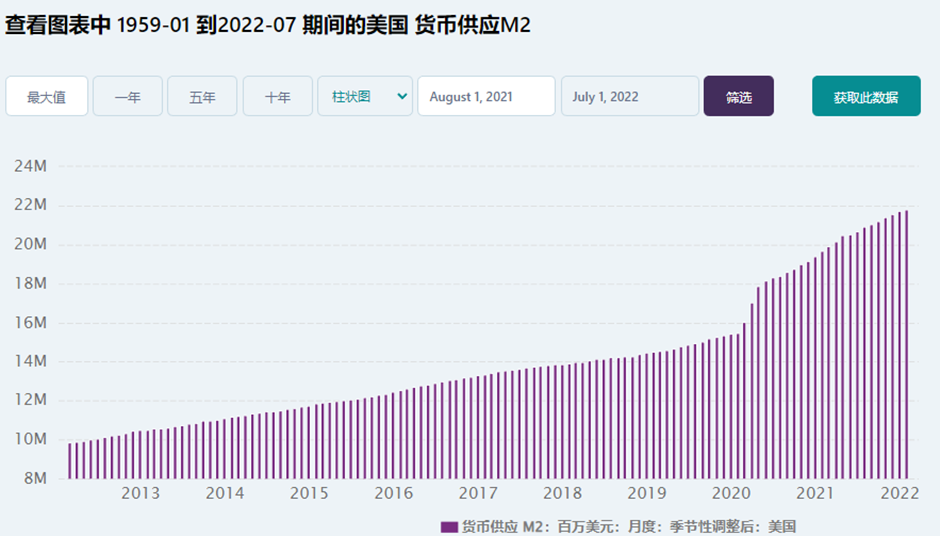
美国的货币流通是澳洲的100倍,现在,汇率基本直奔0.60而去,隔壁邻居新西兰都要崩盘了,新西兰纽币到达了0.5的水位。这是什么意思呢?就意味着,美国流通货币是澳洲的100倍,购买力是澳洲的150%,相当于美国人均比澳洲有钱150倍。M0就是流通中的现金,换句话说就是手头里的钞票。当然,大家也可能说,这个太夸张了。但这个就是客观数字。我再说一个数字,美国的M2数字,是22万亿美金,澳大利亚大约2000多亿。又是100倍的差距。M2也就是广义货币,包括了现金和银行活期存款,涵盖了定期存款,居民储蓄存款和其他金融机构的存款,比如证券公司客户保证金,住房公积金中心存款。

超发100倍,然后还能升值??美国人玩金融真的是厉害。空手套白狼。美元再次“征服”世界。美国经济不好,印钱,美股大涨,美国人发钱,美元贬值,刺激出口和国内消费。经济好了,原材料价格上涨了,加息,全世界资金回流美国,资金回流支撑美股,美元升值,美国人股市不跌,购买力上升了,刺激进口,进口原材料成本降低了,收购海外资产容易了,出去旅游方便了。新兴国家我就不说了,多国汇率腰斩,阿根廷央行存款利率高达75%。最惨的,当属欧洲。内忧外患。英国英镑昨天闪崩,直接向美元英镑评价一路飞奔而去。英镑兑美元在亚洲交易时段中一度狂泻4.5%,创1985年以来新低。英国新任财政大臣Kwasi Kwarteng上周末暗示可能将出台更多减税措施。上周五,英国政府宣布了半个世纪以来最激进的一揽子减税措施,价值450亿英镑,市场对英国债务压力和通胀风险产生了担忧。英国10年期国债收益率开盘飙升22基点至4.05%。
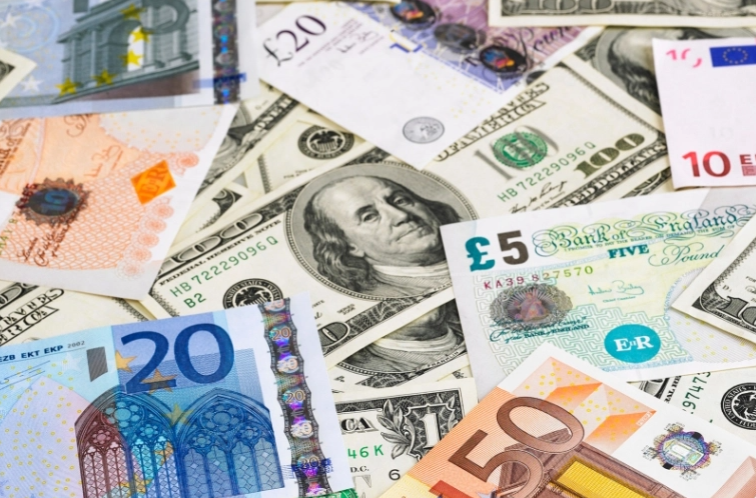
澳元跌破0.65,我们的世界在经历一场战争、一场能源危机、一场全球粮食危机、和一场迫在眉睫的经济危机。这个时候,我们需要提前预判央行的预判,预判政府的预判。未来,财富还会经历多次波动和洗牌。看懂了美国金融的操作,就基本能够守得住自己的财富,并且能够在金融周期中,乘风破浪。免责声明:GO Markets分析师或外部发言人提供的信息基于其独立分析或个人经验。所表达的观点或交易风格仅代表其个人;并不代表GO Markets的观点或立场。联系方式:墨尔本 03 8658 0603悉尼 02 9188 0418中国地区(中文) 400 120 8537中国地区(英文) +248 4 671 903作者:Jacky Wang | GO Markets 亚洲投研部主管

